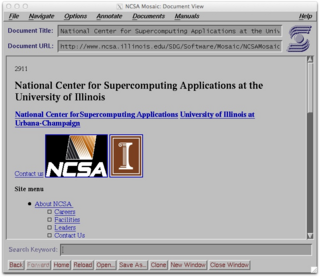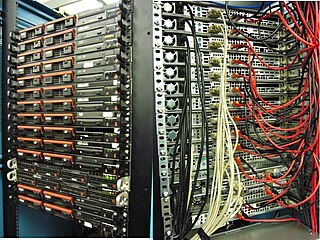Related Research Articles
The Gopher protocol is a communications protocol designed for distributing, searching, and retrieving documents in Internet Protocol networks. The design of the Gopher protocol and user interface is menu-driven, and presented an alternative to the World Wide Web in its early stages, but ultimately fell into disfavor, yielding to the HTTP. The Gopher ecosystem is often regarded as the effective predecessor of the World Wide Web.

The Hypertext Transfer Protocol (HTTP) is an application layer protocol for distributed, collaborative, hypermedia information systems. HTTP is the foundation of data communication for the World Wide Web, where hypertext documents include hyperlinks to other resources that the user can easily access, for example by a mouse click or by tapping the screen in a web browser.

Lynx is a customizable text-based web browser for use on cursor-addressable character cell terminals. As of 2020, it is the oldest web browser still being maintained, having started in 1992.

The World Wide Web (WWW), commonly known as the Web, is an information system where documents and other web resources are identified by Uniform Resource Locators, which may be interlinked by hypertext, and are accessible over the Internet. The resources of the Web are transferred via the Hypertext Transfer Protocol (HTTP), may be accessed by users by a software application called a web browser, and are published by a software application called a web server. The World Wide Web is not synonymous with the Internet, which pre-dated the Web in some form by over two decades and upon which technologies the Web is built.

A web server is server software, or a system of one or more computers dedicated to running this software, that can satisfy client HTTP requests on the public World Wide Web or also on private LANs and WANs.

A website is a collection of web pages and related content that is identified by a common domain name and published on at least one web server. Notable examples are wikipedia.org, google.com, and amazon.com.

NCSA Mosaic is one of the first web browsers. It was instrumental in popularizing the World Wide Web and the general Internet by integrating multimedia such as text and graphics. It is a client for earlier internet protocols such as File Transfer Protocol, Network News Transfer Protocol, and Gopher. It was named for its support of multiple Internet protocols. Its intuitive interface, reliability, personal computer support, and simple installation all contributed to its popularity within the web. Mosaic is the first browser to display images inline with text instead of in a separate window. It is often described as the first graphical web browser, though it was preceded by WorldWideWeb, the lesser-known Erwise, and ViolaWWW.

In computing, a hyperlink, or simply a link, is a reference to data that the user can follow by clicking or tapping. A hyperlink points to a whole document or to a specific element within a document. Hypertext is text with hyperlinks. The text that is linked from is called anchor text. A software system that is used for viewing and creating hypertext is a hypertext system, and to create a hyperlink is to hyperlink. A user following hyperlinks is said to navigate or browse the hypertext.
The File Transfer Protocol (FTP) is a standard network protocol used for the transfer of computer files from a server to a client on a computer network. FTP is built on a client-server model architecture using separate control and data connections between the client and the server. FTP users may authenticate themselves with a clear-text sign-in protocol, normally in the form of a username and password, but can connect anonymously if the server is configured to allow it. For secure transmission that protects the username and password, and encrypts the content, FTP is often secured with SSL/TLS (FTPS) or replaced with SSH File Transfer Protocol (SFTP).
The robots exclusion standard, also known as the robots exclusion protocol or simply robots.txt, is a standard used by websites to communicate with web crawlers and other web robots. The standard specifies how to inform the web robot about which areas of the website should not be processed or scanned. Robots are often used by search engines to categorize websites. Not all robots cooperate with the standard; email harvesters, spambots, malware and robots that scan for security vulnerabilities may even start with the portions of the website where they have been told to stay out. The standard can be used in conjunction with Sitemaps, a robot inclusion standard for websites.
In computer networking, Server Message Block (SMB), one version of which was also known as Common Internet File System, is a communication protocol for providing shared access to files, printers, and serial ports between nodes on a network. It also provides an authenticated inter-process communication mechanism. Most usage of SMB involves computers running Microsoft Windows, where it was known as "Microsoft Windows Network" before the introduction of Active Directory. Corresponding Windows services are LAN Manager Server for the server component, and LAN Manager Workstation for the client component.
The name Atom applies to a pair of related Web standards. The Atom Syndication Format is an XML language used for web feeds, while the Atom Publishing Protocol is a simple HTTP-based protocol for creating and updating web resources.
The computer file hosts is an operating system file that maps hostnames to IP addresses. It is a plain text file. Originally a file named HOSTS.TXT was manually maintained and made available via file sharing by Stanford Research Institute for the ARPANET membership, containing the hostnames and address of hosts as contributed for inclusion by member organizations. The Domain Name System, first described in 1983 and implemented in 1984, automated the publication process and provided instantaneous and dynamic hostname resolution in the rapidly growing network. In modern operating systems, the hosts file remains an alternative name resolution mechanism, configurable often as part of facilities such as the Name Service Switch as either the primary method or as a fallback method.

SlipKnot was one of the earliest World Wide Web browsers, available to Microsoft Windows users between November 1994 and January 1998. It was created by Peter Brooks of MicroMind, Inc. to provide a fully graphical view of the web for users without a SLIP or other TCP/IP connection to the net, hence the name - SLIP...not. SlipKnot provided a graphical web experience through what would otherwise be a text-only Unix shell account. SlipKnot version 1.0 was released on November 22, 1994, approximately 3 weeks before Netscape's Netscape Navigator version 1.0 came out. It was designed to serve a significant fraction of PC/Windows-based Internet users who could not use Mosaic or Netscape at that time.
Digest access authentication is one of the agreed-upon methods a web server can use to negotiate credentials, such as username or password, with a user's web browser. This can be used to confirm the identity of a user before sending sensitive information, such as online banking transaction history. It applies a hash function to the username and password before sending them over the network. In contrast, basic access authentication uses the easily reversible Base64 encoding instead of hashing, making it non-secure unless used in conjunction with TLS.
This is a list of blogging terms. Blogging, like any hobby, has developed something of a specialised vocabulary. The following is an attempt to explain a few of the more common phrases and words, including etymologies when not obvious.
A web desktop or webtop is a desktop environment embedded in a web browser or similar client application. A webtop integrates web applications, web services, client–server applications, application servers, and applications on the local client into a desktop environment using the desktop metaphor. Web desktops provide an environment similar to that of Windows, Mac, or a graphical user interface on Unix and Linux systems. It is a virtual desktop running in a web browser. In a webtop the applications, data, files, configuration, settings, and access privileges reside remotely over the network. Much of the computing takes place remotely. The browser is primarily used for display and input purposes.
A home server is a computing servers located in a private residence providing services to other devices inside or outside the household through a home network or the Internet. Such services may include file and printer serving, media center serving, home automation control, web serving, web caching, file sharing and synchronization, video surveillance and digital video recorder, calendar and contact sharing and synchronization, account authentication, and backup services.

GroupWise is a messaging and collaboration platform from Micro Focus that supports email, calendaring, personal information management, instant messaging, and document management. The GroupWise platform consists of desktop client software, which is available for Windows, Mac OS X, and Linux, and the server software, which is supported on Windows Server and Linux.

Super Dimension Fortress is a non-profit public access UNIX shell provider on the Internet. It has been in continual operation since 1987 as a non-profit social club. The name is derived from the Japanese anime series The Super Dimension Fortress Macross; the original SDF server was a BBS for anime fans. From its BBS roots, which have been well documented as part of the BBS: The Documentary project, SDF has grown into a feature-rich provider serving members around the world.
References
- ↑ WP2Gopher (gopher link)
- ↑ SiMpLe MaChInEs 04-2003 phlog archive (gopher link)
- ↑ "HOWTO: Make a weblog a gopherlog". g13g. 2005-04-03. Retrieved 2018-11-03.